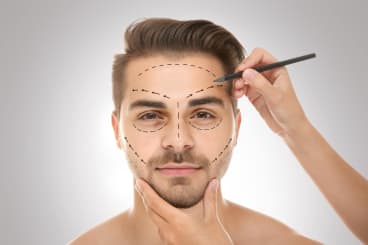 Earlobe Surgery
Earlobe SurgeryHow To Fix Old and Sagging Piercings
Perfect piercings don't last forever. Luckily, it's easy to fix sagging, stretched or old piercings. Plastic surgeon Michael Frederick, MD, tells us just how easy.
Getting piercings can be a rite of passage. Some people have had ear piercings for as long as they can remember, while others can remember the excitement of finally being able to get their ears pierced as a teenager. These piercing holes might look great now, but that doesn't mean they're exempt from changes. Over the years, either from wearing heavy earrings or by voluntarily stretching them, the skin around the area can become loose.
Many patients consult dermatologists or cosmetic surgeons because they dislike the appearance of their older piercings or feel the loose skin is a giveaway of their age. And though it is easy to fix, earlobe sagging and other undesired piercing scarring is often overlooked as part of a more traditional anti-aging routine. Piercings on other parts of the body can also be affected by a range of factors, including the general aging process and pregnancy. One particularly common complaint is the appearance of navel piercings after having children, but, like earlobe repair, it's an easy fix.
What Causes Earlobe Sagging?
There are two primary causes for ear piercings becoming larger over time: wearing heavy earrings for long periods and purposefully stretching earlobes using spacers. As with any part of the body, with age, skin becomes weaker and shows a loss of elasticity due to lower levels of collagen production. The earlobes themselves also tend to get larger throughout adulthood, a phenomenon that is mostly attributed to gravity.
How Can Earlobe Sagging Be Treated?
Earlobe sagging can be treated through corrective surgery and can be carried out as a procedure on its own or as part of more widespread treatment. “The procedure is straightforward and is carried out using local anesthesia," says board certified plastic surgeon Michael Frederick, MD, of Hass Plastic Surgery in West Palm Beach, FL. "When there is a large amount of excess skin, it can be a little more complicated, but with a bit of ‘skin origami,’ patients will be able to achieve the results they were looking for.” Most commonly, the procedure involves sewing the opening closed and removing excess skin to refashion the shape of the earlobe. Dr. Frederick says he commonly addresses stretched earlobes in conjunction with other operations. It's particularly common in combination with facelifts, but the procedure can be done if you are under anesthetic for almost any other cosmetic procedure too. Pricing for earlobe piercing correction as a stand-alone procedure varies widely, between $300 and $1,000 depending on what type of repair is required and whether or not you want the procedure on both ears.
Are There Any Possible Complications?
Dr. Frederick notes that it’s important to be mindful about re-piercing the ear after the repair is carried out. "The ear can be re-pierced within days of the procedure if it is pierced in a different place to the scar," he says. "However, if the patient wants a new piercing in the exact same place, they will need to wait up to six months for the scar to be strong enough.” Since scar tissue is more delicate than normal skin, re-piercing too soon could result in the need for further corrective surgery by damaging the scar.
The risk of infection in the area is no higher than any other procedure, so keeping the area clean and appropriately bandaged after the procedure should prevent possible infection.
There is little downtime for this procedure alone. If it is carried out using only local anesthesia, patients will be able to return to their daily activities within hours. Stitches remain in place for about a week, and after they are removed, caring for your scar is important by applying a topical scar treatment.
What About Other Piercings?
Piercings in other parts of the body can also leave marks, either from the scar left behind once they are taken out or from stretching during pregnancy or weight gain. Both surface piercings (piercings that have an entry and exit point such as nose piercings and navel piercings) and dermal piercings (piercings held in place by a base) can be corrected by a dermatologist or cosmetic surgeon. The main goal of repairing a piercing is to restore the area to its natural appearance before it was pierced and the principle for treatment is similar to that of ear piercings. The practitioner will create a small incision and create a new, neat scar designed to disappear once healed.
What About Stretch Marks Around a Navel Piercing?
Many women who had their navel pierced before they had children find that the area around the piercing tends to accumulate a large number of stretch marks during pregnancy. The treatment for these stretch marks is different than for those who are simply looking to remove the pierced skin, mainly because stretch marks are more widespread. Your practitioner may suggest having the piercing addressed in addition to treating the stretch marks. Stretch marks can be treated using a number of methods including laser treatment and microdermabrasion. The cost of treatment varies depending on the location of the marks and you can expect to pay a further $500 to $900 for stretch marks treatment depending on the size of the area being treated.
Are There Any Possible Complications?
Similar to ear piercing repair, the risks associated with body piercing corrections are minimal. Most of them are carried out under local anesthesia and require little downtime. With careful wound management, they should not be particularly prone to infection. Patients should contact a board certified dermatologist or cosmetic surgeon if they are considering having the procedure. If you will be undergoing treatment for stretch marks around a navel piercing, you can expect a level of discomfort after either laser or microdermabrasion. Patients often say it feels like a sunburn, but this should only last a couple of days following each treatment.
The ability to virtually erase any trace of an old piercing is attractive to many patients and the ease of the procedure makes it a viable option for most people. Patients do need to keep in mind that there will be a small scar after the procedure, but if they take good care of it during the healing process it can disappear over time. It is a good idea to discuss how to reduce scarring when you have a consultation with your physician, particularly if the piercing that is being treated is in a very visible spot as it could take longer to fully heal.
Related Procedures

AI Plastic Surgeon™
powered by'Try on' aesthetic procedures and instantly visualize possible results with The AI Plastic Surgeon, our patented 3D aesthetic simulator.


